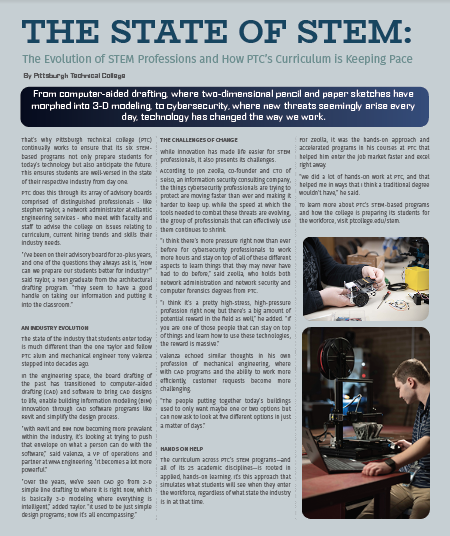MindShare: The State of STEM
By Pittsburgh Technical College
 From computer-aided drafting, where two-dimensional pencil and paper sketches have morphed into 3-D modeling, to cybersecurity, where new threats seemingly arise every day, technology has changed the way we work.
From computer-aided drafting, where two-dimensional pencil and paper sketches have morphed into 3-D modeling, to cybersecurity, where new threats seemingly arise every day, technology has changed the way we work.
That’s why Pittsburgh Technical College (PTC) continually works to ensure that its six STEM-based programs not only prepare students for today’s technology but also anticipate the future. This ensures students are well-versed in the state of their respective industry from day one.
PTC does this through its array of advisory boards comprised of distinguished professionals - like Stephen Taylor, a network administrator at Atlantic Engineering Services - who meet with faculty and staff to advise the College on issues relating to curriculum, current hiring trends and skills their industry needs.
“I’ve been on their advisory board for 20-plus years, and one of the questions they always ask is, ‘How can we prepare our students better for industry?’” said Taylor, a 1981 graduate from the architectural drafting program. “They seem to have a good handle on taking our information and putting it into the classroom.”
An Industry Evolution
The state of the industry that students enter today is much different than the one Taylor and fellow PTC alum and mechanical engineer Tony Valenza stepped into decades ago.
In the engineering space, the board drafting of the past has transitioned to computer-aided drafting (CAD) and software to bring CAD designs to life, enable building information modeling (BIM) innovation through CAD software programs like Revit and simplify the design process.
“With Revit and BIM now becoming more prevalent within the industry, it’s looking at trying to push that envelope on what a person can do with the software,” said Valenza, a VP of operations and partner at WNA Engineering. “It becomes a lot more powerful.”
“Over the years, we’ve seen CAD go from 2-D simple line drafting to where it is right now, which is basically 3-D modeling where everything is intelligent,” added Taylor. “It used to be just simple design programs; now it’s all encompassing.”
The Challenges of Change
While innovation has made life easier for STEM professionals, it also presents its challenges.
According to Jon Zeolla, co-founder and CTO of Seiso, an information security consulting company, the things cybersecurity professionals are trying to protect are moving faster than ever and making it harder to keep up. While the speed at which the tools needed to combat these threats are evolving, the group of professionals that can effectively use them continues to shrink.
“I think there’s more pressure right now than ever before for cybersecurity professionals to work more hours and stay on top of all of these different aspects to learn things that they may never have had to do before,” said Zeolla, who holds both network administration and network security and computer forensics degrees from PTC.
“I think it’s a pretty high-stress, high-pressure profession right now, but there’s a big amount of potential reward in the field as well,” he added. “If you are one of those people that can stay on top of things and learn how to use these technologies, the reward is massive.”
Valenza echoed similar thoughts in his own profession of mechanical engineering, where with CAD programs and the ability to work more efficiently, customer requests become more challenging.
“The people putting together today’s buildings used to only want maybe one or two options but can now ask to look at five different options in just a matter of days.”
Hands on Help
The curriculum across PTC’s STEM programs—and all of its 25 academic disciplines—is rooted in applied, hands-on learning. It’s this approach that simulates what students will see when they enter the workforce, regardless of what state the industry is in at that time.
For Zeolla, it was the hands-on approach and accelerated programs in his courses at PTC that helped him enter the job market faster and excel right away.
“We did a lot of hands-on work at PTC, and that helped me in ways that I think a traditional degree wouldn’t have,” he said.
To learn more about PTC’s STEM-based programs and how the college is preparing its students for the workforce, visit ptcollege.edu/stem.